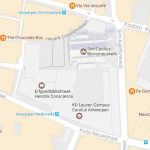Conscienceplein: het begin van een nieuwe tijd (2)
De bibliotheek
Donderdag beëindigde ik mijn bericht met de gebouwen aan de westkant van het Conscienceplein: de sodaliteiten. Toen de paus de jezuïetenorde afschafte in 1773 werden al hun gebouwen aan het plein, en alles wat er in zat, publiek verkocht. De gebouwen van de sodaliteit kregen verschillende functies. Zo werden ze atelier, winkel, opslagruimte, dancing, café (er staat nog een aankondiging van een brouwer op de gevel aan de zijkant). In 1879 kocht de Stad de gebouwen aan om er de Stadsbibliotheek in onder te brengen.

Feitelijk waren het er twee: een bibliotheek van oude, waardevolle boeken en manuscripten, en een bibliotheek waar gewone boeken in ondergebracht waren die uitgeleend konden worden. Dat verklaart waarom op het einde van de 19de eeuw een beeld van Hendrik Conscience geplaatst is in de nis van de sodaliteit. Op dat moment was Hendrik Conscience de belangrijkste figuur in de Vlaamse literatuur. Zijn populariteit in Vlaanderen kan je vergelijken met de populariteit van Victor Hugo in Frankrijk.
Van 1622 totdat de Franse revolutionairen het vernietigden stond in dezelfde nis een beeltenis van de Heilige Maagd.
De inkom van de bibliotheek bevindt zich nu aan de Korte Nieuwstraat. Geleide wandelingen vinden geregeld plaats en de 19de eeuwse ‘Nottebohmzaal’ is een bezoekje overwaard. Deze bezoeken beginnen aan de groene deur in de zuid-west hoek van het plein. [http://www.consciencebibliotheek.be/nl]
De kerk
Tegenover de sodaliteiten bevindt zich de vroegere jezuïetenkerk, toegewijd aan Carolus Borromeüs. Algemeen wordt gesteld dat Rubens een belangrijk aandeel heeft gehad in de decoratie op de voorgevel en dat hij ook meegewerkt heeft aan de klokkentoren, die zich aan de achterkant aan de Sint-Kathelijnevest bevindt.
De kerk is duidelijk in de typische jezuïetenstijl gebouwd en bevat heel wat verwijzingen naar de Il Gesù kerk in Rome. De kerk in detail beschrijven zou ons hier te ver leiden. Daar kom ik later wel eens op terug.
Het plein

In de jaren 60 was dit plein de plaats waar een artistieke rel onstond, die snel door heel wat jongeren in de stad gevolgd werd, om Koning Auto een halte toe te roepen. Met enorme ijsblokken werd de toegang tot het plein onmogelijk gemaakt voor auto’s. Muzikanten, kunstenaars, dansers en gewone voetgangers namen het plein in. De opstand was een succes en niet alleen het plein, maar ook de belendende straten vormde de eerste autovrije zone in Antwerpen. Voor begrafenissen en trouwpartijen kunnen auto’s natuurlijk nog altijd het plein oprijden.
